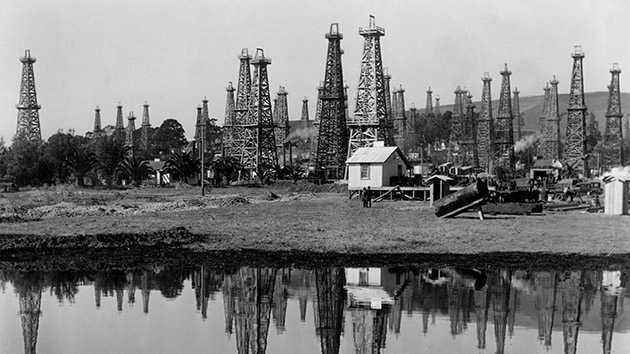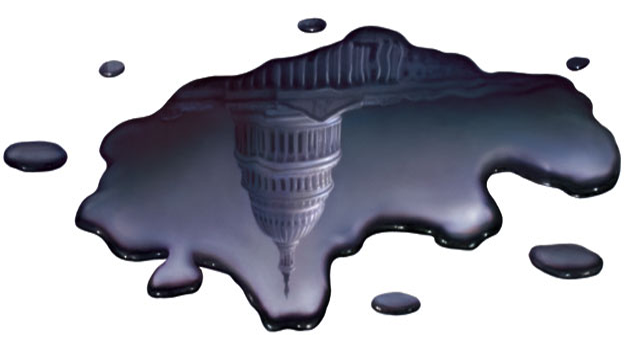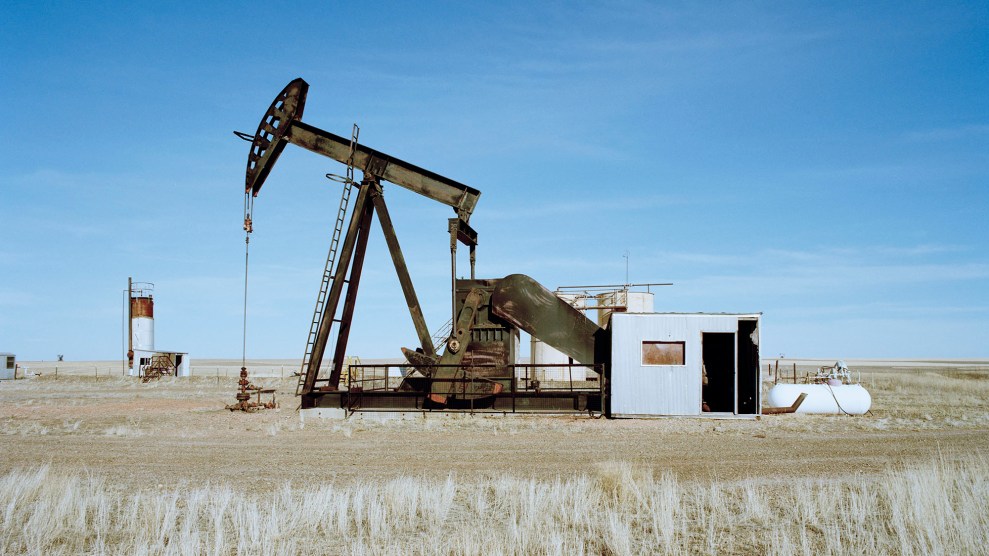
Oil derricks and a "lake" of spilled crude in Santa Barbara, California, in 1935.Associated Press
Over the past century, the federal government has pumped more than $470 billion into the oil and gas industry in the form of generous, never-expiring tax breaks. How it all got started:
| 1916 | The petroleum industry takes off as Americans’ love affair with the automobile begins. A new tax provision allows oil companies to write off dry holes as well as all “intangible drilling costs” in their first year of exploration. Over the next 15 years, oil and gas subsidies will average $1.9 billion a year in today’s dollars. |
| 1926 | Congress approves the “depletion allowance,” which lets oil producers deduct more than a quarter of their gross revenues. Texas Sen. Tom Connally, who sponsored the break, later admits, “We could have taken a 5 or 10 percent figure, but we grabbed 27.5 percent because we were not only hogs but the odd figure made it appear as though it was scientifically arrived at.” |
| 1937 | Treasury Secretary Henry Morgenthau calls the depletion allowance “perhaps the most glaring loophole” in the tax code. President Franklin D. Roosevelt urges Congress to close it and other tax-evasion methods “so widespread and so amazing, both in their boldness and their ingenuity, that further action without delay seems imperative.” |
| 1947 | Natural gas drillers in Kansas first experiment with hydraulic fracturing, or fracking, but the technology won’t be widely used until the federal government backs its development in the 1970s. |
| 1950 | President Harry S. Truman unsuccessfully prods Congress to end the depletion allowance. |
| 1957 | Asked about the depletion allowance, President Dwight Eisenhower replies, “I am not prepared to say it is evil because, while we do find, I assume, that a number of rich men take advantage of it unfairly, there must certainly be an incentive in this country if we are going to continue the exploration for gas and oil that is so important to our economy.” |
| 1960 | Presidential candidates John F. Kennedy and Richard Nixon debate the depletion allowance. Kennedy says he’s willing to review and close the “loophole.” Nixon counters, “I favor the present depletion allowance. I favor it not because I want to make a lot of oilmen rich, but because I want to make America rich.” |
| 1969 | Congress cuts the depletion allowance deduction from 27.5 to 23 percent, over the objections of the president of Gulf Oil, who calls it “a cornerstone, a major part of the foundation on which the industry has built its house. To dismantle it in whole or in part could very well jeopardize that whole structure and, to a serious degree, the economy dependent upon it.” President Nixon says the tax break is “in the national interest” because Mideast oil supplies could be cut off “in the event of a world conflict.” |
| 1974 | With the OPEC oil embargo and energy crisis at full tilt, Nixon vows to do “everything in my power to prevent the big oil companies and other major energy producers from making an unconscionable profit out of this crisis.” President Gerald Ford authorizes the creation of the Energy Research and Development Administration to oversee energy R&D. Over the next five years, federal spending on fossil fuel research jumps tenfold to $1.4 billion. |
| 1975 | Ford almost vetoes but then signs a tax bill that repeals the depletion allowance for large companies. It remains in place for smaller, independent drillers. |
| 1975-77 | The Department of Energy oversees the first successful applications of large-scale fracking to extract oil and gas. |
| 1977 | President Jimmy Carter praises Sen. Russell Long of oil-rich Louisiana for voting “to do away with the oil depletion allowance, which was a very courageous thing to do.” |
| 1978 | Carter signs a “gas guzzler” tax on new cars that don’t meet federal mileage standards. |
| 1979 | Carter installs solar panels on the White House roof. President Ronald Reagan removes them in 1986. |
| 1980 | Carter signs a $228 billion tax on oil companies’ windfall profits as well as a tax credit to encourage the development of shale and tar oil, coalbed methane, and other unconventional fossil fuels. |
| 1985 | President Reagan takes aim at federal tax breaks. Oil and gas is one of few industries to emerge unscathed from the “showdown at Gucci Gulch.” He fails to convince Congress to kill the depletion allowance for most oil wells. |
| 1988 | As oil prices sink, Congress repeals the windfall profits tax. |
| 1990 | A bill signed by President George H.W. Bush doubles the gas guzzler tax and increases gasoline excise taxes. It also establishes a new tax credit for retrofitting existing oil wells to boost production, expands the tax credit for unconventional oil production, and loosens the depletion allowance. |
| 1992 | The Energy Policy Act establishes tax credits for renewable energy production and introduces tax deductions for cars powered by electricity and alternative fuels. |
| 1995 | President Bill Clinton signs the Deep Water Royalty Relief Act, letting oil companies drill in federal waters without paying any royalties. More than 1,000 leases omit a promised price trigger, costing billions. |
| 1999 | Clinton extends the loosened rules for the depletion allowance. |
| 2001 | President George W. Bush and first lady Laura Bush claim a $733 depletion allowance on their income taxes. |
| 2004 | The American Jobs Creation Act extends a tax break to oil companies for not shipping domestic jobs overseas. |
| 2005 | With oil prices on the rise, President George W. Bush states, “With $55 [a barrel] oil, we don’t need incentives to oil and gas companies to explore.” But a few months later, he signs the Energy Policy Act, which expands the depletion allowance to apply to more drillers. It also lets companies write off exploration costs over two years instead of one. |
| 2006 | Rep. John Larson (D-Conn.) introduces the Oil Subsidy Elimination Act, which could end many of Big Oil’s most lucrative tax breaks. It never gets out of committee. |
| 2007 | Illinois Sen. Barack Obama introduces the Oil sense (Subsidy Elimination for New Strategies on Energy) Act, which would repeal the depletion allowance and suspend royalty-free leases in the Gulf of Mexico. The bill dies in the Democratic-controlled Senate Finance Committee. A House bill that would have expanded tax credits for renewable energy and energy conservation also dies. |
| 2008 | Annual tax subsidies for renewable energy shoot past those for oil and gas. |
| 2009 | President Obama’s stimulus package includes $90 billion for energy efficiency and renewable-energy projects, including wind and solar electricity generation, fuel cells, and electric vehicles. |
| 2010 | The Simpson-Bowles deficit reduction plan proposes modifying or eliminating all tax expenditures and raising the gas tax by 15 cents. Former Fed chairman Alan Greenspan likewise suggests that “oil and gas depletion allowances could be restructured” as direct subsidies. |
| 2011 | House Speaker John Boehner tells abc News, “I don’t think the big oil companies need to have the oil depletion allowances.” Asked if oil subsidies should be cut, he answers, “They ought to be paying their fair share.” His spokesman clarifies: “The Speaker made clear in the interview that raising taxes was a non-starter, and he’s told the president that. He simply wasn’t going to take the bait and fall into the trap of defending ‘Big Oil’ companies.” Executives of the big five oil companies testify before Congress about their tax breaks. In their defense, Sen. Orrin Hatch (R-Utah) calls the hearing “a dog and pony show” and displays a photograph of a dog sitting on a pony. A national survey finds that 7 in 10 Americans (including nearly 7 in 10 Republicans) oppose fossil fuel subsidies. |
| 2012 | Sen. Bob Menendez (D-N.J.) introduces the Repeal Big Oil Tax Subsidies Act, which would end $2.4 billion in tax breaks for the big five oil companies. Obama challenges Congress to “eliminate this oil industry giveaway right away.” Unable to get filibuster-proof support, it dies. Mitt Romney says oil subsidies go “largely to small companies, to drilling operators and so forth.” He says he’d consider cutting them—if tax rates were slashed first. The American Petroleum Institute launches a $3 million postelection media blitz, including ads that warn seven Democratic senators up for reelection in 2014 against touching the industry’s tax breaks: “American energy—not higher taxes on energy—will create jobs.” |
| 2013 | Despite talk of everything being “on the table,” oil’s tax perks survive the fiscal-cliff negotiations. Congressional Democrats introduce five bills targeting tax giveaways for oil and gas companies. Their death is all but assured, especially in the Republican-controlled House. In April, Obama introduces his 2014 budget, which includes $23 billion for renewable energy and energy efficiency over 10 years and permanent tax cuts for renewable power generation. It also would end “inefficient fossil fuel subsidies.” In contrast, the gop budget proposed by Wisconsin Rep. Paul Ryan targets “federal intervention and corporate-welfare spending” by cutting subsidies for renewables. Tax breaks for oil are left untouched. |

















